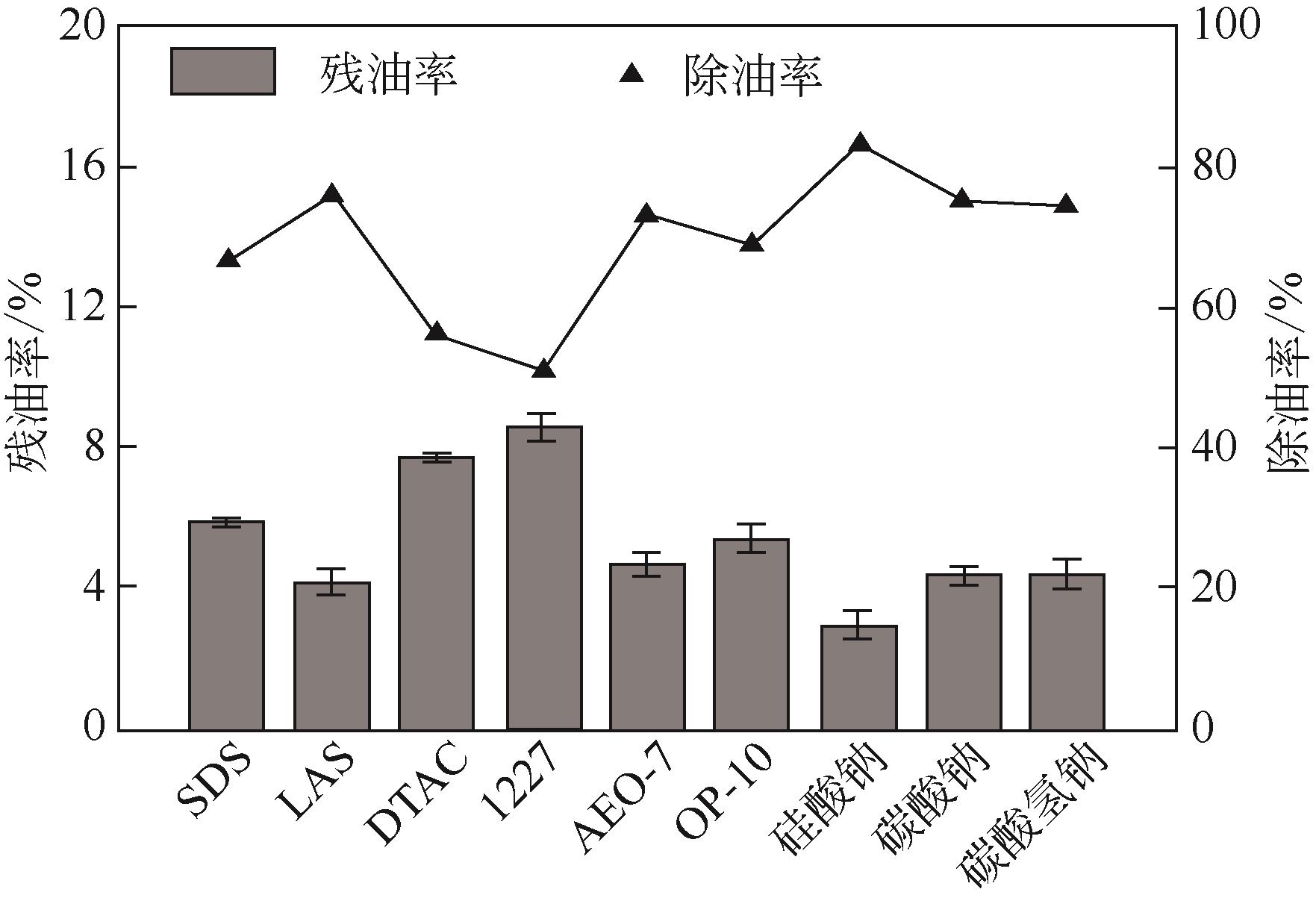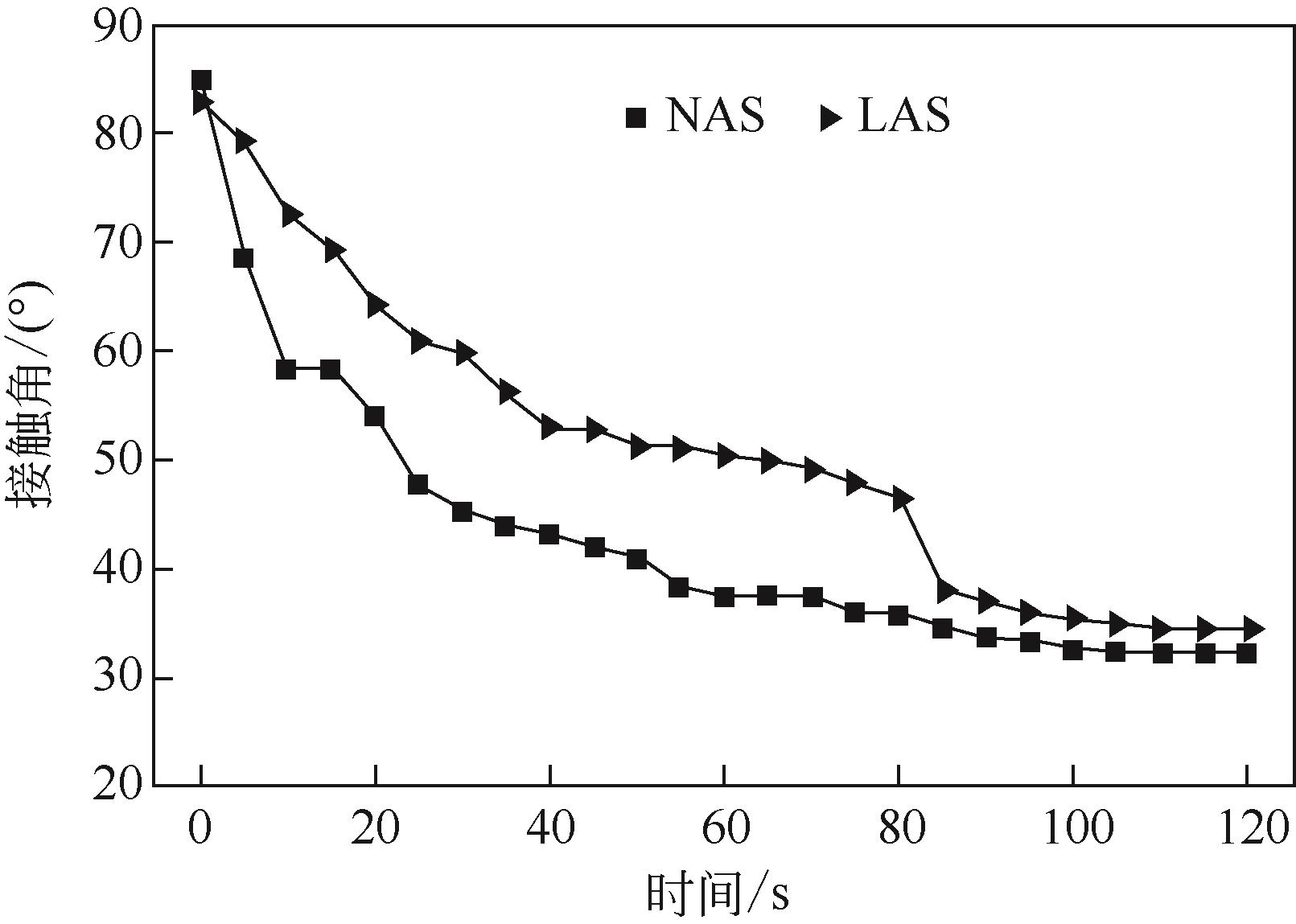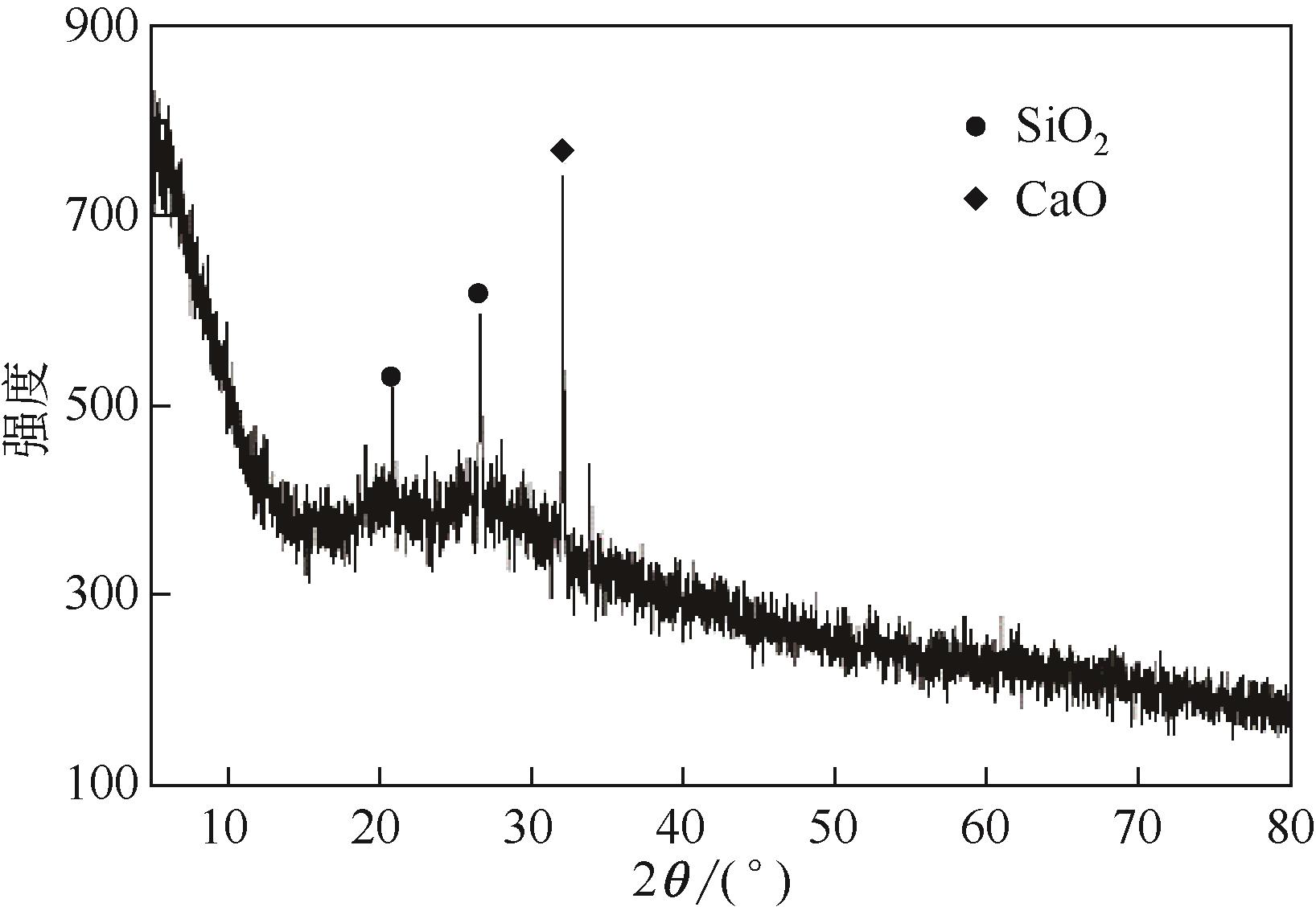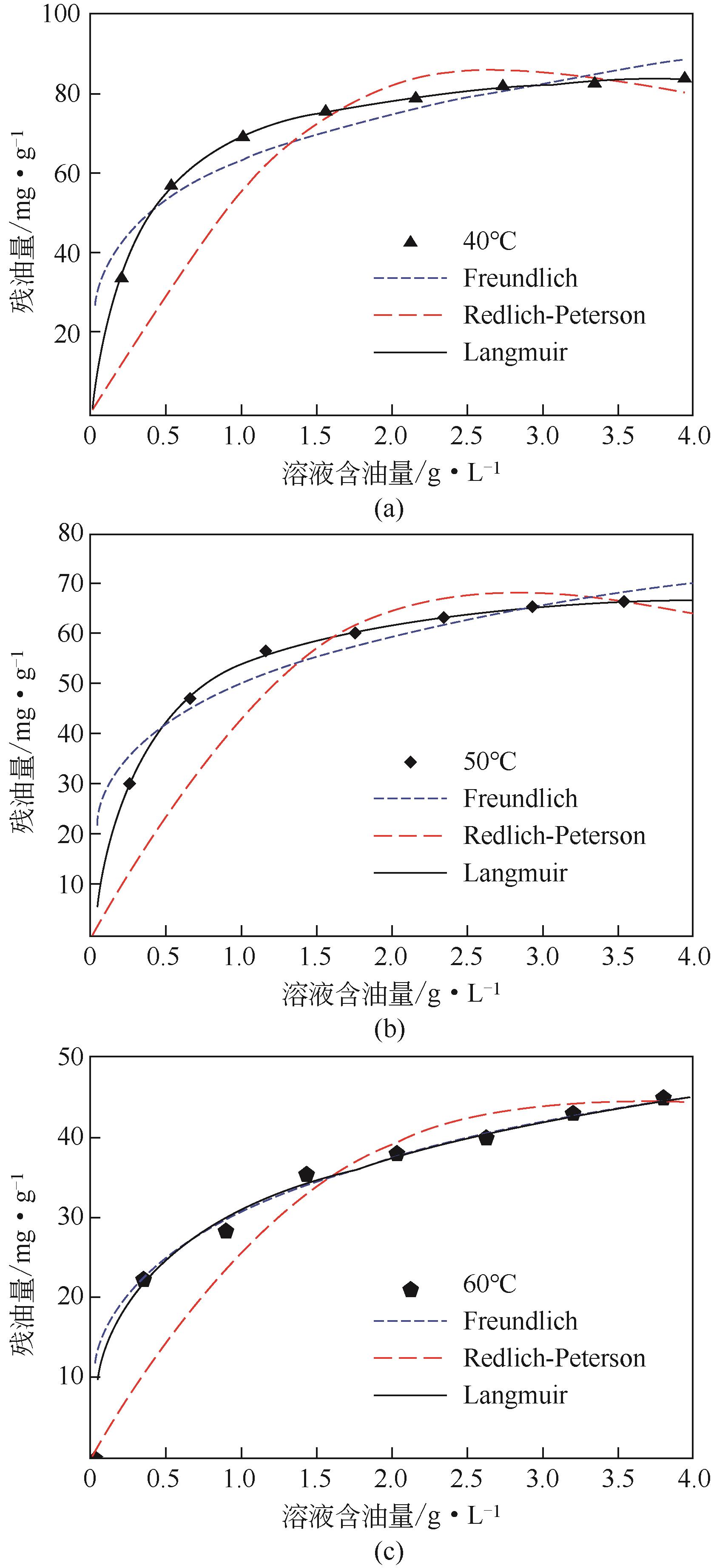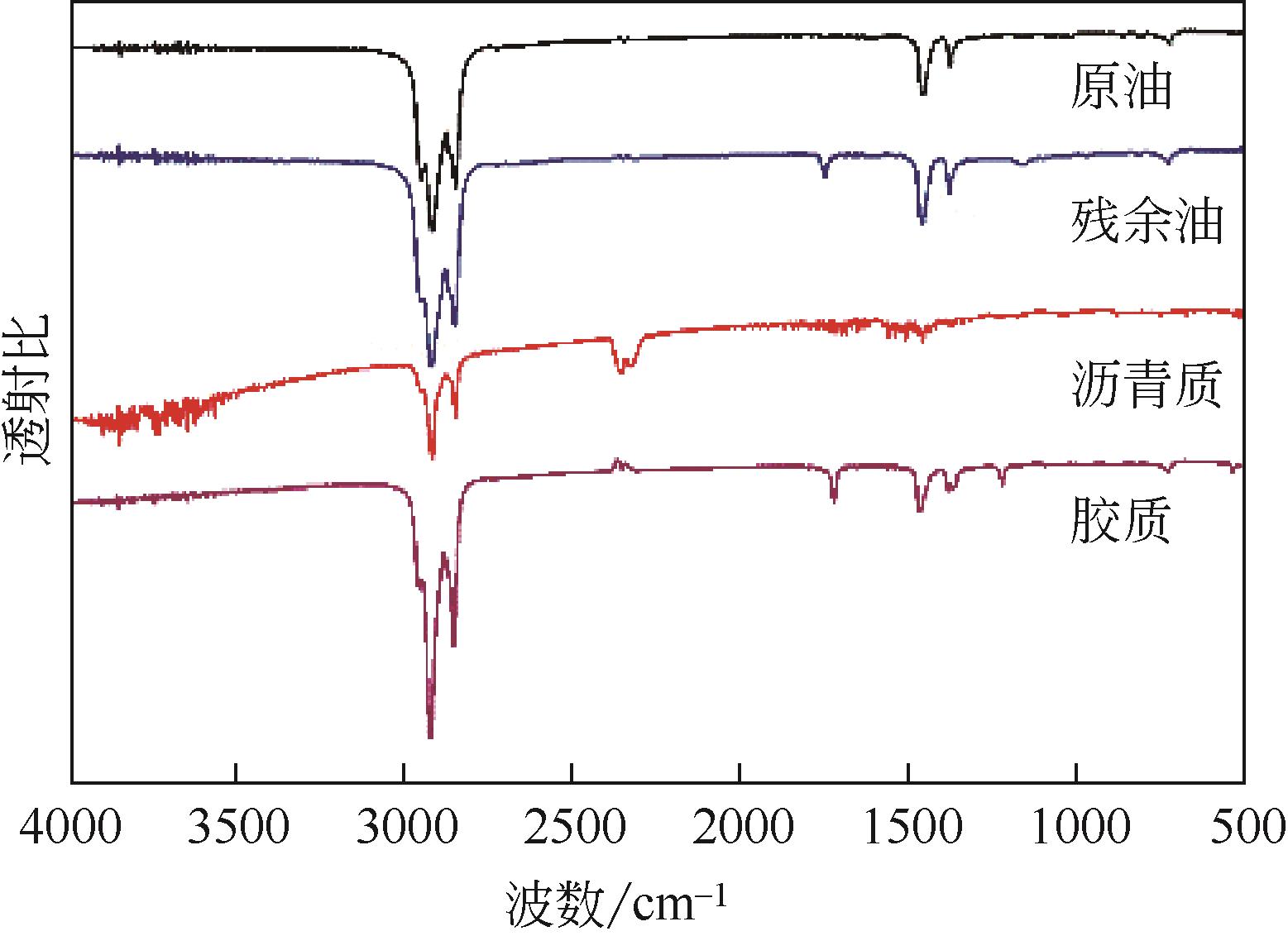Chemical Industry and Engineering Progress ›› 2022, Vol. 41 ›› Issue (6): 3333-3340.DOI: 10.16085/j.issn.1000-6613.2021-1376
• Resources and environmental engineering • Previous Articles Next Articles
Performance and mechanism of thermochemical technology for oily sludge cleaning
WANG Yujing1( ), ZHANG Nan1, LIU Shejiang1(
), ZHANG Nan1, LIU Shejiang1( ), MIAO Chen1, LIU Xiuli2
), MIAO Chen1, LIU Xiuli2
- 1.School of Environmental Science & Engineering, Tianjin University, Tianjin 300350, China
2.Tianjin Huanke Environmental Consulting Co. , Ltd. , Tianjin 300191, China
-
Received:2021-06-30Revised:2021-08-12Online:2022-06-21Published:2022-06-10 -
Contact:LIU Shejiang
热化学清洗含油污泥的效果评价及机理
王宇晶1( ), 张楠1, 刘涉江1(
), 张楠1, 刘涉江1( ), 苗辰1, 刘秀丽2
), 苗辰1, 刘秀丽2
- 1.天津大学环境科学与工程学院,天津 300350
2.天津环科环境咨询有限公司,天津 300191
-
通讯作者:刘涉江 -
作者简介:王宇晶(1997—),女,硕士研究生,研究方向为含油污泥处理。E-mail:1289243065@qq.com 。 -
基金资助:天津市重点研发科技支撑重点项目(19YFZCSF01090)
CLC Number:
Cite this article
WANG Yujing, ZHANG Nan, LIU Shejiang, MIAO Chen, LIU Xiuli. Performance and mechanism of thermochemical technology for oily sludge cleaning[J]. Chemical Industry and Engineering Progress, 2022, 41(6): 3333-3340.
王宇晶, 张楠, 刘涉江, 苗辰, 刘秀丽. 热化学清洗含油污泥的效果评价及机理[J]. 化工进展, 2022, 41(6): 3333-3340.
share this article
Add to citation manager EndNote|Ris|BibTeX
URL: https://hgjz.cip.com.cn/EN/10.16085/j.issn.1000-6613.2021-1376
| 清洗剂 | Na2SiO3/% | LAS/% | AEO-7/% | 残油率/% | 除油率/% |
|---|---|---|---|---|---|
| NLA | 33.33 | 33.33 | 33.33 | 2.32 | 86.80 |
| NAS | 50.00 | 50.00 | 0.00 | 1.87 | 89.38 |
| NAE | 50.00 | 0.00 | 50.00 | 2.15 | 87.77 |
| LAE | 0.00 | 50.00 | 50.00 | 2.74 | 84.41 |
| NSE | 50.00 | 40.00 | 10.00 | 2.28 | 87.03 |
| NSO | 50.00 | 30.00 | 20.00 | 2.35 | 86.65 |
| 清洗剂 | Na2SiO3/% | LAS/% | AEO-7/% | 残油率/% | 除油率/% |
|---|---|---|---|---|---|
| NLA | 33.33 | 33.33 | 33.33 | 2.32 | 86.80 |
| NAS | 50.00 | 50.00 | 0.00 | 1.87 | 89.38 |
| NAE | 50.00 | 0.00 | 50.00 | 2.15 | 87.77 |
| LAE | 0.00 | 50.00 | 50.00 | 2.74 | 84.41 |
| NSE | 50.00 | 40.00 | 10.00 | 2.28 | 87.03 |
| NSO | 50.00 | 30.00 | 20.00 | 2.35 | 86.65 |
| 序号 | 因素 | 残油率 /% | |||
|---|---|---|---|---|---|
| 温度/℃ | 时间/min | 液固比 | 清洗剂质量分数/% | ||
| 1 | 50 | 40 | 5∶1 | 3 | 4.73 |
| 2 | 50 | 60 | 6∶1 | 4 | 2.37 |
| 3 | 50 | 80 | 8∶1 | 5 | 2.13 |
| 4 | 60 | 40 | 6∶1 | 5 | 1.86 |
| 5 | 60 | 60 | 6∶1 | 3 | 1.73 |
| 6 | 60 | 80 | 5∶1 | 4 | 2.82 |
| 7 | 70 | 40 | 6∶1 | 4 | 1.54 |
| 8 | 70 | 60 | 5∶1 | 5 | 2.12 |
| 9 | 70 | 80 | 6∶1 | 3 | 3.60 |
| K1 | 3.08 | 2.71 | 3.22 | 3.02 | |
| K2 | 1.80 | 1.74 | 2.61 | 2.04 | |
| K3 | 2.42 | 2.85 | 1.47 | 2.24 | |
| R | 1.27 | 1.11 | 0.61 | 0.98 | |
| 序号 | 因素 | 残油率 /% | |||
|---|---|---|---|---|---|
| 温度/℃ | 时间/min | 液固比 | 清洗剂质量分数/% | ||
| 1 | 50 | 40 | 5∶1 | 3 | 4.73 |
| 2 | 50 | 60 | 6∶1 | 4 | 2.37 |
| 3 | 50 | 80 | 8∶1 | 5 | 2.13 |
| 4 | 60 | 40 | 6∶1 | 5 | 1.86 |
| 5 | 60 | 60 | 6∶1 | 3 | 1.73 |
| 6 | 60 | 80 | 5∶1 | 4 | 2.82 |
| 7 | 70 | 40 | 6∶1 | 4 | 1.54 |
| 8 | 70 | 60 | 5∶1 | 5 | 2.12 |
| 9 | 70 | 80 | 6∶1 | 3 | 3.60 |
| K1 | 3.08 | 2.71 | 3.22 | 3.02 | |
| K2 | 1.80 | 1.74 | 2.61 | 2.04 | |
| K3 | 2.42 | 2.85 | 1.47 | 2.24 | |
| R | 1.27 | 1.11 | 0.61 | 0.98 | |
| 模型 | 参数 | 40℃ | 50℃ | 60℃ |
|---|---|---|---|---|
| Langmuir | Q0/mg·g-1 | 89.2479 | 72.2862 | 54.6426 |
| KL/L·g-1 | 2.3534 | 2.9185 | 3.3579 | |
| R2 | 0.9988 | 0.9967 | 0.9908 | |
| Freundlich | KF | 63.1455 | 50.1569 | 30.5280 |
| 1/n | 0.2221 | 0.2395 | 0.2848 | |
| R2 | 0.9149 | 0.9208 | 0.9889 | |
| Redlich-Peterson | KRP | 61.4854 | 48.9305 | 30.3957 |
| α | 0.1168 | 0.1288 | 0.1766 | |
| β | 2.0952 | 1.9972 | 1.6523 | |
| R2 | 0.8667 | 0.8889 | 0.9295 |
| 模型 | 参数 | 40℃ | 50℃ | 60℃ |
|---|---|---|---|---|
| Langmuir | Q0/mg·g-1 | 89.2479 | 72.2862 | 54.6426 |
| KL/L·g-1 | 2.3534 | 2.9185 | 3.3579 | |
| R2 | 0.9988 | 0.9967 | 0.9908 | |
| Freundlich | KF | 63.1455 | 50.1569 | 30.5280 |
| 1/n | 0.2221 | 0.2395 | 0.2848 | |
| R2 | 0.9149 | 0.9208 | 0.9889 | |
| Redlich-Peterson | KRP | 61.4854 | 48.9305 | 30.3957 |
| α | 0.1168 | 0.1288 | 0.1766 | |
| β | 2.0952 | 1.9972 | 1.6523 | |
| R2 | 0.8667 | 0.8889 | 0.9295 |
| T/K | lnKL | ?G?/kJ mol-1 | ?S?/J·mol-1·K-1 | ?H?/kJ mol-1 |
|---|---|---|---|---|
| 313 | 0.86 | -2.23 | 817.36 | 0.23 |
| 323 | 1.07 | -2.88 | — | — |
| 333 | 1.21 | -3.35 | — | — |
| T/K | lnKL | ?G?/kJ mol-1 | ?S?/J·mol-1·K-1 | ?H?/kJ mol-1 |
|---|---|---|---|---|
| 313 | 0.86 | -2.23 | 817.36 | 0.23 |
| 323 | 1.07 | -2.88 | — | — |
| 333 | 1.21 | -3.35 | — | — |
| 1 | LYU X, SONG Z L, YU J, et al. Study on the demulsification of refinery oily sludge enhanced by microwave irradiation[J]. Fuel, 2020, 279: 118417. |
| 2 | LIU J, LI X C, JIA W H, et al. Demulsification of crude oil-in-water emulsions driven by graphene oxide nanosheets[J]. Energy & Fuels, 2015, 29(7): 4644-4653. |
| 3 | ZHENG X H, ABORISADE M A, LIU S J, et al. The history and prediction of composting technology: a patent mining[J]. Journal of Cleaner Production, 2020, 276: 124232. |
| 4 | MRAYYAN B, BATTIKHI M N. Biodegradation of total organic carbons (TOC) in Jordanian petroleum sludge[J]. Journal of Hazardous Materials, 2005, 120(1/2/3): 127-134. |
| 5 | PINHEIRO B C A, HOLANDA J N F. Processing of red ceramics incorporated with encapsulated petroleum waste[J]. Journal of Materials Processing Technology, 2009, 209(15/16): 5606-5610. |
| 6 | 张楠, 王宇晶, 刘涉江, 等. 含油污泥化学热洗技术研究现状与进展[J]. 化工进展, 2021, 40(3): 1276-1283. |
| ZHANG Nan, WANG Yujing, LIU Shejiang, et al. Progress and prospects on the thermochemical cleaning of oily sludge[J]. Chemical Industry and Engineering Progress, 2021, 40(3): 1276-1283. | |
| 7 | 肖楠, 朱玲, 王春雨, 等. 含油污泥化学清洗处理实验研究与工艺参数优化[J]. 环境工程学报, 2019, 13(5): 1202-1208. |
| XIAO Nan, ZHU Ling, WANG Chunyu, et al. Experimental study and process parameters optimization for oily sludge treatment by chemical cleaning[J]. Chinese Journal of Environmental Engineering, 2019, 13(5): 1202-1208. | |
| 8 | HU G J, LI J B, ZENG G M. Recent development in the treatment of oily sludge from petroleum industry: a review[J]. Journal of Hazardous Materials, 2013, 261: 470-490. |
| 9 | 白羽, 程远鹏, 胡九江, 等. 含油污泥热清洗处理技术研究现状与展望[J]. 应用化工, 2020, 49(6): 1498-1501, 1507. |
| BAI Yu, CHENG Yuanpeng, HU Jiujiang, et al. Progress and prospects of thermal cleaning and treatment of oily sludge[J]. Applied Chemical Industry, 2020, 49(6): 1498-1501, 1507. | |
| 10 | REDDY M V, DEVI M P, CHANDRASEKHAR K, et al. Aerobic remediation of petroleum sludge through soil supplementation: microbial community analysis[J]. Journal of Hazardous Materials, 2011, 197: 80-87. |
| 11 | 梁宏宝, 刘福生, 陈博, 等. 含油污泥热化学清洗剂的研制与清洗效果实验分析[J]. 环境工程学报, 2017, 11(11): 6117-6123. |
| LIANG Hongbao, LIU Fusheng, CHEN Bo, et al. Development of chemical cleaning agents of oily sludge and analysis of washing effect experiment[J]. Chinese Journal of Environmental Engineering, 2017, 11(11): 6117-6123. | |
| 12 | 姜勇, 赵萍, 董铁有, 等. 含油污泥油含量测定方法[J]. 环境科学与管理, 2008, 33(2): 115-117. |
| JIANG Yong, ZHAO Ping, DONG Tieyou, et al. Determination methods for oil concentration in the oily sludge[J]. Environmental Science and Management, 2008, 33(2): 115-117. | |
| 13 | KOELSCH P, MOTSCHMANN H. Varying the counterions at a charged interface[J]. Langmuir, 2005, 21(8): 3436-3442. |
| 14 | SANTOS F K G, NETO E L B, MOURA M C P A, et al. Molecular behavior of ionic and nonionic surfactants in saline medium[J]. Colloids and Surfaces A: Physicochemical and Engineering Aspects, 2009, 333(1/2/3): 156-162. |
| 15 | LIU J J, XU Z H, MASLIYAH J. Interaction forces in bitumen extraction from oil sands[J]. Journal of Colloid and Interface Science, 2005, 287(2): 507-520. |
| 16 | LU Z Y, LIU W, BAO M T, et al. Oil recovery from polymer-containing oil sludge in oilfield by thermochemical cleaning treatment[J]. Colloids and Surfaces A: Physicochemical and Engineering Aspects, 2021, 611: 125887. |
| 17 | JIN Y Q, ZHENG X Y, CHU X L, et al. Oil recovery from oil sludge through combined ultrasound and thermochemical cleaning treatment[J]. Industrial & Engineering Chemistry Research, 2012, 51(27): 9213-9217. |
| 18 | WU M L, DICK W A, LI W, et al. Bioaugmentation and biostimulation of hydrocarbon degradation and the microbial community in a petroleum-contaminated soil[J]. International Biodeterioration & Biodegradation, 2016, 107: 158-164. |
| 19 | MATER L, SPERB R M, MADUREIRA L A, et al. Proposal of a sequential treatment methodology for the safe reuse of oil sludge-contaminated soil[J]. Journal of Hazardous Materials, 2006, 136(3): 967-971. |
| 20 | ZHAO M, LIU D, LI Z H, et al. Inspection for desorption behavior and desorption mechanism of oily sludge by thermodynamics and kinetics analysis[J]. Journal of the Taiwan Institute of Chemical Engineers, 2018, 93: 226-233. |
| 21 | RAMIASA M, RALSTON J, FETZER R, et al. The influence of topography on dynamic wetting[J]. Advances in Colloid and Interface Science, 2014, 206: 275-293. |
| 22 | LI X G, BAI Y, SUI H, et al. Understanding desorption of oil fractions from mineral surfaces[J]. Fuel, 2018, 232: 257-266. |
| 23 | LUO X M, GONG H Y, HE Z L, et al. Research on mechanism and characteristics of oil recovery from oily sludge in ultrasonic fields[J]. Journal of Hazardous Materials, 2020, 399: 123137. |
| [1] | LI Mengyuan, GUO Fan, LI Qunsheng. Simulation and optimization of the third and fourth distillation columns in the recovery section of polyvinyl alcohol production [J]. Chemical Industry and Engineering Progress, 2023, 42(S1): 113-123. |
| [2] | ZHANG Ruijie, LIU Zhilin, WANG Junwen, ZHANG Wei, HAN Deqiu, LI Ting, ZOU Xiong. On-line dynamic simulation and optimization of water-cooled cascade refrigeration system [J]. Chemical Industry and Engineering Progress, 2023, 42(S1): 124-132. |
| [3] | WANG Tai, SU Shuo, LI Shengrui, MA Xiaolong, LIU Chuntao. Dynamic behavior of single bubble attached to the solid wall in the AC electric field [J]. Chemical Industry and Engineering Progress, 2023, 42(S1): 133-141. |
| [4] | SUN Jipeng, HAN Jing, TANG Yangchao, YAN Bowen, ZHANG Jieyao, XIAO Ping, WU Feng. Numerical simulation and optimization of operating parameters of sulfur wet molding process [J]. Chemical Industry and Engineering Progress, 2023, 42(S1): 189-196. |
| [5] | WANG Shengyan, DENG Shuai, ZHAO Ruikai. Research progress on carbon dioxide capture technology based on electric swing adsorption [J]. Chemical Industry and Engineering Progress, 2023, 42(S1): 233-245. |
| [6] | CHEN Kuangyin, LI Ruilan, TONG Yang, SHEN Jianhua. Structure design of gas diffusion layer in proton exchange membrane fuel cell [J]. Chemical Industry and Engineering Progress, 2023, 42(S1): 246-259. |
| [7] | YANG Yudi, LI Wentao, QIAN Yongkang, HUI Junhong. Analysis of influencing factors of natural gas turbulent diffusion flame length in industrial combustion chamber [J]. Chemical Industry and Engineering Progress, 2023, 42(S1): 267-275. |
| [8] | CUI Shoucheng, XU Hongbo, PENG Nan. Simulation analysis of two MOFs materials for O2/He adsorption separation [J]. Chemical Industry and Engineering Progress, 2023, 42(S1): 382-390. |
| [9] | XU Ruosi, TAN Wei. Flow field simulation and fluid-structure coupling analysis of C-tube pool boiling two-phase flow model [J]. Chemical Industry and Engineering Progress, 2023, 42(S1): 47-55. |
| [10] | ZHANG Fengqi, CUI Chengdong, BAO Xuewei, ZHU Weixuan, DONG Hongguang. Design and evaluation of sweetening process with amine solution absorption and multiple desorption [J]. Chemical Industry and Engineering Progress, 2023, 42(S1): 518-528. |
| [11] | GUO Qiang, ZHAO Wenkai, XIAO Yonghou. Numerical simulation of enhancing fluid perturbation to improve separation of dimethyl sulfide/nitrogen via pressure swing adsorption [J]. Chemical Industry and Engineering Progress, 2023, 42(S1): 64-72. |
| [12] | SHAO Boshi, TAN Hongbo. Simulation on the enhancement of cryogenic removal of volatile organic compounds by sawtooth plate [J]. Chemical Industry and Engineering Progress, 2023, 42(S1): 84-93. |
| [13] | XU Youhao, WANG Wei, LU Bona, XU Hui, HE Mingyuan. China’s oil refining innovation: MIP development strategy and enlightenment [J]. Chemical Industry and Engineering Progress, 2023, 42(9): 4465-4470. |
| [14] | CHEN Lin, XU Peiyuan, ZHANG Xiaohui, CHEN Jie, XU Zhenjun, CHEN Jiaxiang, MI Xiaoguang, FENG Yongchang, MEI Deqing. Investigation on the LNG mixed refrigerant flow and heat transfer characteristics in coil-wounded heat exchanger (CWHE) system [J]. Chemical Industry and Engineering Progress, 2023, 42(9): 4496-4503. |
| [15] | DONG Jiayu, WANG Simin. Experimental on ultrasound enhancement of para-xylene crystallization characteristics and regulation mechanism [J]. Chemical Industry and Engineering Progress, 2023, 42(9): 4504-4513. |
| Viewed | ||||||
|
Full text |
|
|||||
|
Abstract |
|
|||||
